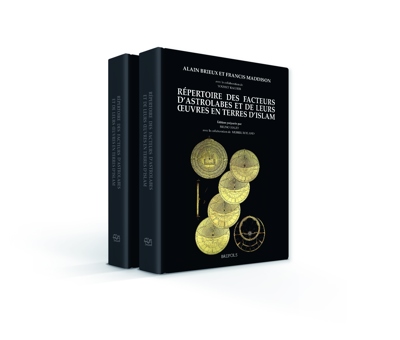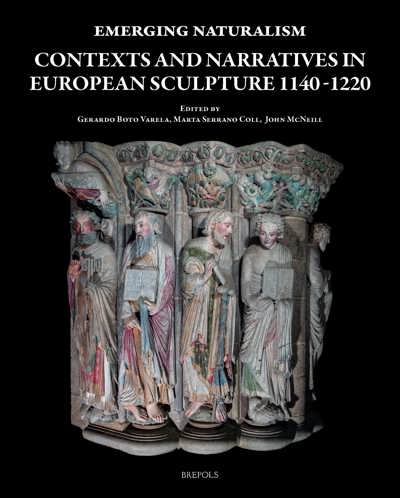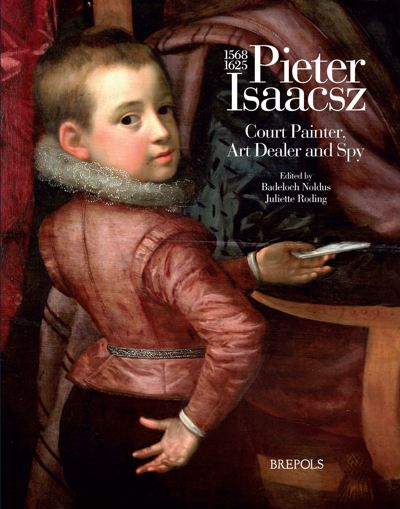
Emerging Naturalism: Contexts and Narratives in European Sculpture 1140-1220
Gerardo Boto Varela, Marta Serrano Coll, John McNeill (eds)
- Pages: 436 p.
- Size:220 x 280 mm
- Illustrations:156 b/w, 18 col.
- Language(s):English
- Publication Year:2020
- € 100,00 EXCL. VAT RETAIL PRICE
- ISBN: 978-2-503-57448-6
- Hardback
- Available
“(…) it is beautifully produced and richly illustrated with clear photographs that bring the sculptures almost to life. Above all, it includes many sculptural programs that are little known or published outside of their respective countries of origin. By uniting French, German, Italian, English, and Spanish materials in a single English-language volume, the editors have done a tremendous service toward fostering a truly international discourse. It is to be hoped that this handsome, substantive book will thus reach a wide audience of both specialists and students, bringing fresh attention to the field.” (Shirin Fozi, in Speculum, 98/4, 2023, p. 1217)
Gerardo Boto Varela teaches art history at the Universitat de Girona (Spain), is leader of the international research group Templa, and scientific editor of the journal Codex Aquilarensis. Revista de Arte Medieval. His research concentrates on spatial, pictorial, and liturgical aspects of Spanish ecclesiastical architecture from the tenth to thirteenth centuries, as well as on dynastic tombs and memorial culture in Medieval Iberia.
Marta Serrano Coll teaches art history at the Universitat Rovira i Virgili in Tarragona (Spain) and specializes in Medieval architecture and sculpture, particularly in Catalonia. Her research interests include the display of power through artworks and royal patronage in the Iberian Peninsula during the Middle Ages. In addition, she has published in the field of Romanesque sculpture and hagiographical studies.
John McNeill teaches at Oxford University’s Department of Continuing Education, and is Honorary Secretary of the British Archaeological Association, for whom he has edited and contributed to volumes on Anjou, King’s Lynn and the Fens, the medieval cloister, and English medieval chantries. He was instrumental in establishing a biennial International Romanesque Conference Series and has a particular interest in the design of medieval monastic precincts.
For many decades, specialists in Romanesque and Early Gothic art and architecture have questioned the usefulness of traditional stylistic terminology. It is regarded as having limited relevance insofar as it fails to reflect the complexity and plurality of the period under discussion. Nor does it embrace functional, formal or iconographic specificities. Despite these deficiencies, we still have no better way of referring to the art of the period than Romanesque, Late Romanesque or Early Gothic which we make yet more cumbersome by adding a geographical or political term.
Of the various media which were affected by artistic innovation in Europe during the second half of the 12th century, particular attention has been paid to stained glass, manuscript illumination, metalwork and enamel. Monumental sculpture was equally subject to profound change during the period, in addition to developing in directions that were largely independent of other media. As a result, late Romanesque sculpture extends across the period from 1140 to 1220, from Saxony to Galicia, though it is still impossible to encapsulate in a single statement what this complex network represented. However, the attainment of a compelling naturalism does seem to have been a shared aspiration among Latin European sculptors.
Emerging Naturalism: Contexts and Narratives in European Sculpture 1140–1220 offers a panoramic analysis of this artistic landscape, focused on a central issue in medieval European artistic production. To narrow this field of study, the book concentrates on the innovations and solutions adopted in the great church workshops of western Europe.
Emerging Naturalism and a New Medieval Morphology — Herbert L. Kessler
I. Shaping Late Romanesque Sculpture. Balance and Perspective
The Attainment of a Compelling Naturalism in Sculpture c. 1200 — Gerardo Boto Varela
What is So-Called Late Romanesque Sculpture? — Xavier Barral i Altet
II. Late Romanesque / Early Gothic Sculpture in European Cathedrals (1140–1220)
The Role of Burgundy in the Development of the First Column-Statues — Marcello Angheben
Late Romanesque Sculpture and the Cathedrals of South-Western France — Quitterie Cazes
An Enigma Put Aside. The Origin and Interpretation of a Decontextualized Capital from Saint Trophime at Arles — Juan Antonio Olañeta
Around and After 1200. Old and New Concepts of Monumental Sculpture in the German Territories of the Holy Roman Empire — Claudia Rückert
Sculpture and Liturgy: Monuments and Art Histories of Southern Italy (c. 1150–1250 and Beyond) — Elisabetta Scirocco
Old Testament Sacrifice and Thirteenth-Century Tithe: Cain and Abel in the Architectural Sculpture of the Holy Roman Empire — Stephanie Luther
Late Romanesque Sculpture in England. How Far Can the Evidence Take Us? — John McNeill
The Gothic Last Judgment Portal c. 1210. Visual Strategies and Communicative Function — Bruno Boerner
Aesthetics and the Imitation of Antiquity in Early Gothic Sculpture — Laurence Terrier Aliferis
III. Sculptural Visualisations in the Cathedrals of the Iberian Kingdoms (1160–1220)
The Reception of Burgundian Models in the Second Half of the Twelfth Century and the Naturalist Redefinition of Romanesque Sculpture in Castile — Marta Poza Yagüe
Master Mateo and the Cathedral of Santiago at the End of the Twelfth Century — Ramón Yzquierdo Peiró
Late Romanesque Sculpture in the Kingdoms of Leon and Castile: Continuity or Change? — José Luis Hernando Garrido & Antonio Ledesma
Romanesque Sculpture in Portuguese Cathedrals: Models, Continuity and Adaptation — Carla Varela Fernandes & Paulo Almeida Fernandes
The Meaning of the Romanesque Sculpture in the Cámara Santa at the Cathedral of Oviedo — César García de Castro Valdés
Images and Stories: The Transformation of Space in the Cathedrals of the Ebro Valley — Esther Lozano López
The Vault Corbels in the Cloister of Tarragona Cathedral: Shaping a New Pictorial Corporeality that Goes Beyond the Late Romanesque — Gerardo Boto Varela & Marta Serrano Coll




